Author: Lucio Chachamovich

-
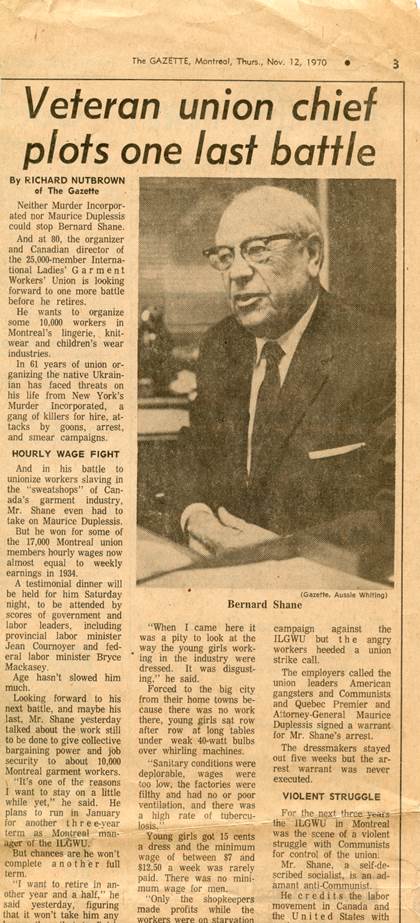 Newsclipping about Bernard Shane in the Montreal Gazette (1970).Photo Credit : Jewish Public Library - Archives
Newsclipping about Bernard Shane in the Montreal Gazette (1970).Photo Credit : Jewish Public Library - Archives -
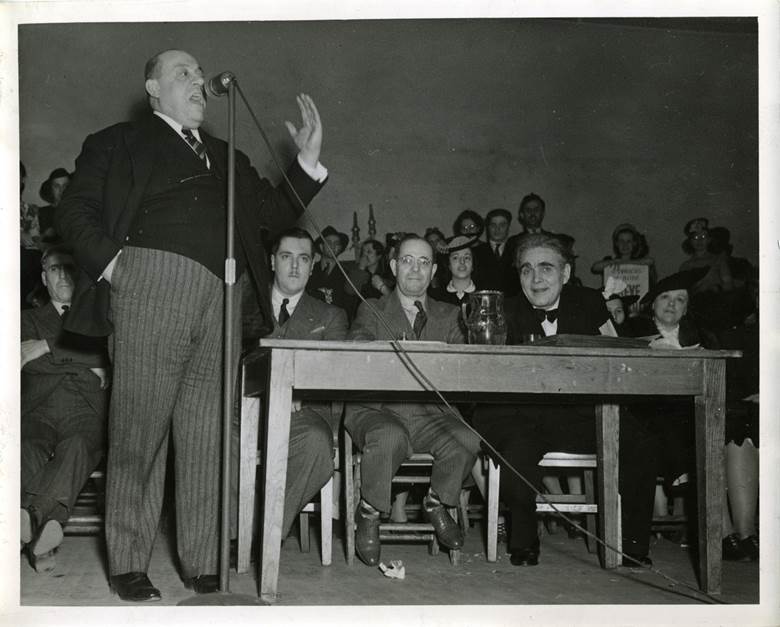 Bernard Shane speaking at a CCF Convention (1950s).Photo Credit : Jewish Public Library - Archives
Bernard Shane speaking at a CCF Convention (1950s).Photo Credit : Jewish Public Library - Archives -
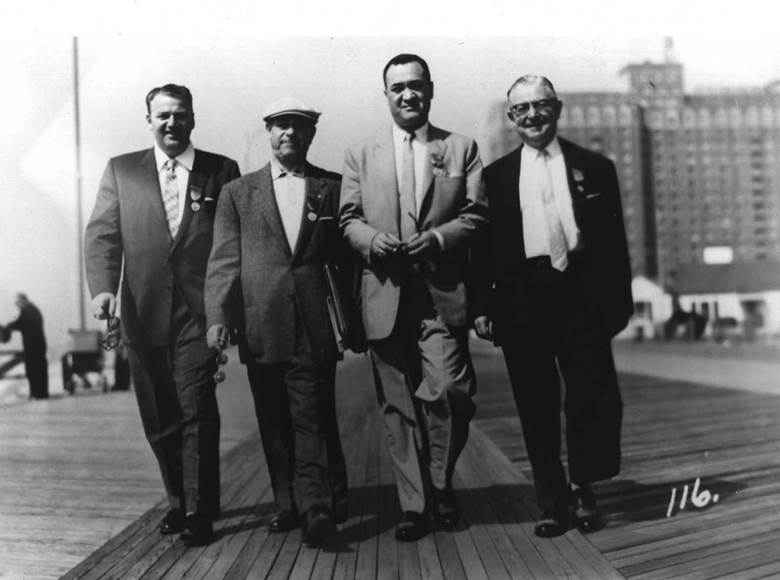 Bernard Shane walking down the Atlantic City Boardwalk with other members of the Jewish Labour Committee.Photo Credit : Alex Dworkin Canadian Jewish Archives
Bernard Shane walking down the Atlantic City Boardwalk with other members of the Jewish Labour Committee.Photo Credit : Alex Dworkin Canadian Jewish Archives -
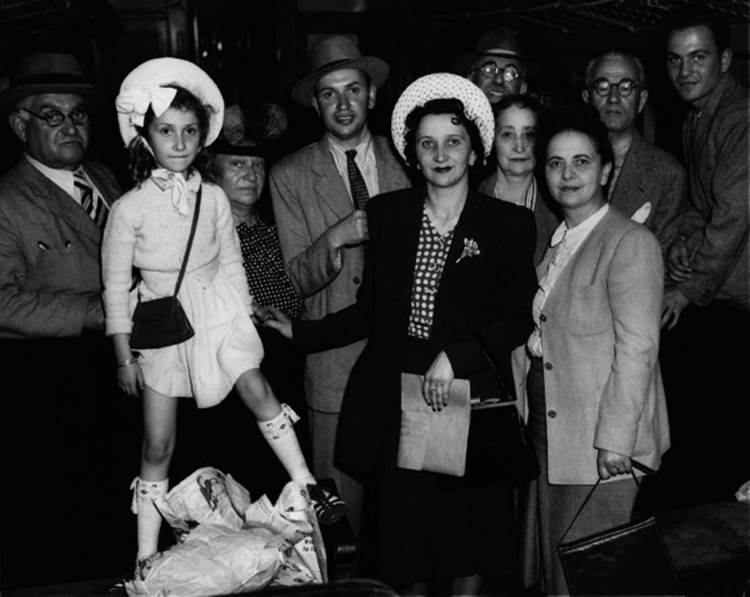 Jewish immigrants arriving in Montreal after WWII. Many of these immigrants were brought to Canada through the initiative of the Tailor's Project.Photo Credit : Alex Dworkin Canadian Jewish Archives
Jewish immigrants arriving in Montreal after WWII. Many of these immigrants were brought to Canada through the initiative of the Tailor's Project.Photo Credit : Alex Dworkin Canadian Jewish Archives
Bernard Shane and Maurice Silcoff
Bernard Shane was a labour organizer active in the Tailor’s Project. Maurice Silcoff was a union founder and president for decades in Montreal.
Bernard Shane was born in Russia and came to the US in 1906. An organizer for the International Ladies’ Garment Workers’ Union (ILGWU), he moved to Toronto in 1934. After the war, he moved again, this time to Montreal, where he found the working standards for women in dressmaking abysmal. The so-called midinettes – from midi (noon) and dinette (short lunch), i.e. the “short-lunches” – were not permitted proper breaks or lunch hours. They might work as much as 80 hours per week in season for as little as $5 – $10 per week, and were then laid off in the quiet season.
In 1947, Shane was active in the Tailor’s Project, as described below. Later on, he served as President of the Jewish Labour Committee.
Born in Dublin, Maurice Silcoff immigrated to Canada in 1910. His parents died soon thereafter of tuberculosis. Raised by distant cousins, Silcoff and his brother went to work at the Acme Hat Company at the age of 12, for about 20 cents per hour. This sensitized the young boy to the tribulations of child labourers and unfair standards. 13 years later, he returned to the Acme Hat Company, but this time as the President of the local Canadian United Hatters, Cap and Millinery Workers Union. He also served as President of the International Leather Goods, Plastics and Novelty Workers’ Union until his retirement at age 80.
Silcoff’s son, Joel, sits on Quebec’s Superior Court.
Tailor’s Project
Silcoff and Shane, along with David Lewis, were active in the Tailor’s Project, a program designed to overcome Canada’s anti-Semitic immigration laws by bringing desperate Holocaust survivors into Canada as much-needed garment workers. Silcoff and Shane were given army positions and authorized to go to the Displaced Persons Camps and choose potential refugees. Although ostensibly a Tailor’s Project, Silcoff and Shane maintained an open definition of “garment worker,” bringing in a good number of musicians, artists, rabbis and intellectuals.
Special thanks to the Museum of Jewish Montreal.
Learn more:
http://imjm.ca/location/1250
http://imjm.ca/location/1412
Franklin Bialystok, Delayed Impact: The Holocaust and the Canadian Jewish Community.
Gerald Tulchinsky, Branching Out: The Transformation of the Canadian Jewish Community
http://www.theglobeandmail.com/news/national/montreal-labour-leader-maurice-silcoff-took-the-high-road/article10763343/

-
 1967 Liquor Ad, Seagram's 7 Crown Whiskey, "After 5".Photo Credit : Classic Film
1967 Liquor Ad, Seagram's 7 Crown Whiskey, "After 5".Photo Credit : Classic Film -
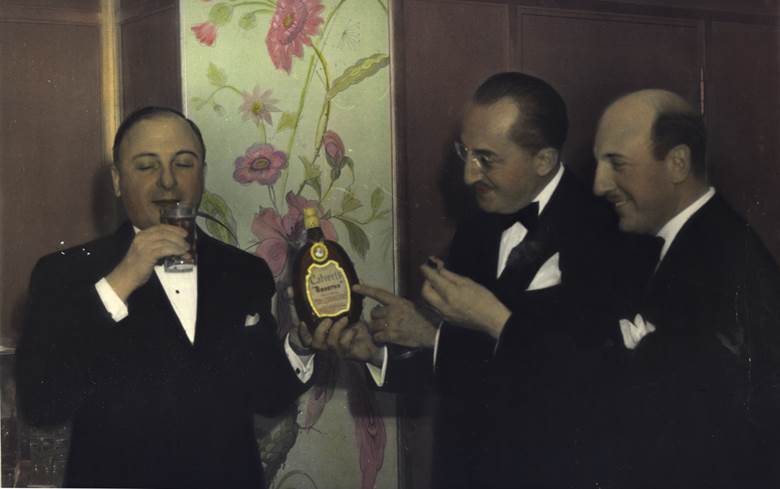 Samuel Bronfman sampling a bottle of his reserve liquor from 1937.Photo Credit : Alex Dworkin Canadian Jewish Archives
Samuel Bronfman sampling a bottle of his reserve liquor from 1937.Photo Credit : Alex Dworkin Canadian Jewish Archives -
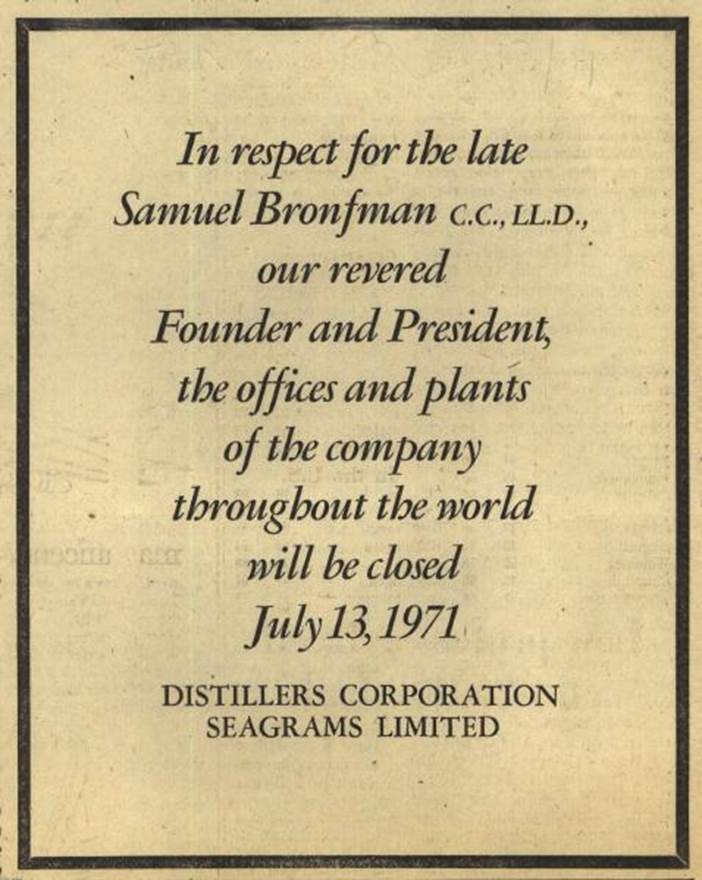 Memo sent out to all of Seagrams Limited on the day of Samuel Bronfman’s death on July 13th 1971.Photo Credit : Alex Dworkin Canadian Jewish Archives
Memo sent out to all of Seagrams Limited on the day of Samuel Bronfman’s death on July 13th 1971.Photo Credit : Alex Dworkin Canadian Jewish Archives -
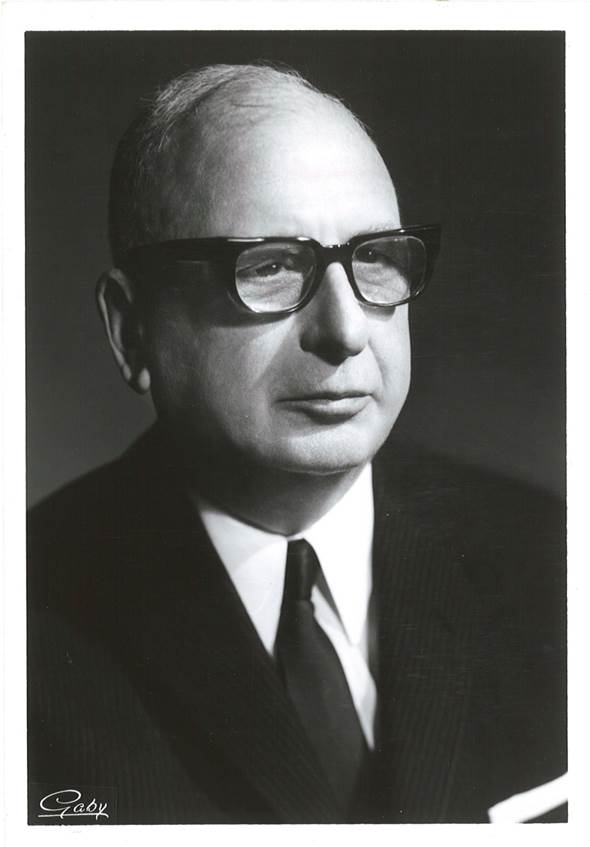 Sam Bronfman.Photo Credit : Jewish Public Library - Archives
Sam Bronfman.Photo Credit : Jewish Public Library - Archives -
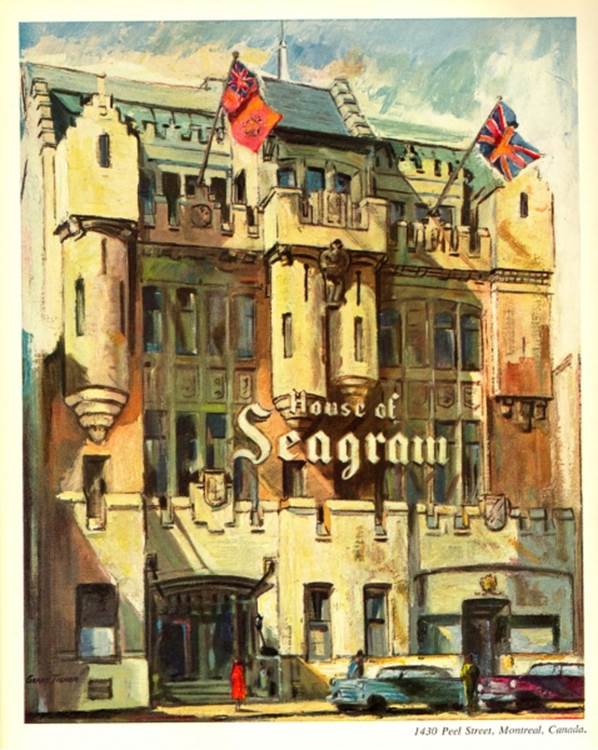 Cover of Seagram 1958 annual report with image of House of Seagram building on Peel Street.Photo Credit : Alex Dworkin Canadian Jewish Archives
Cover of Seagram 1958 annual report with image of House of Seagram building on Peel Street.Photo Credit : Alex Dworkin Canadian Jewish Archives -
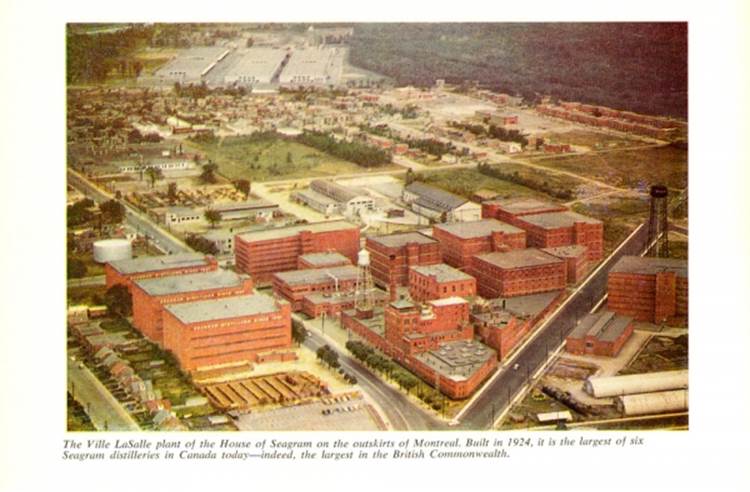 Picture of the Seagram factory in Lasalle from the Seagram 1957 annual report.Photo Credit : Alex Dworkin Canadian Jewish Archives
Picture of the Seagram factory in Lasalle from the Seagram 1957 annual report.Photo Credit : Alex Dworkin Canadian Jewish Archives -
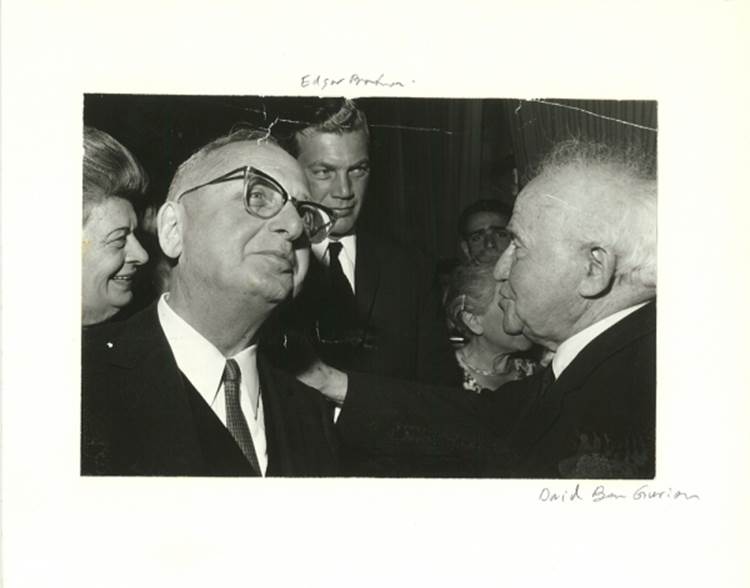 Saidye Bronfman, Samuel Bronfman, Edgar Bronfman Sr., and David Ben Gurion, Montreal, ca. 1961.Photo Credit : Jewish Public Library - Archives
Saidye Bronfman, Samuel Bronfman, Edgar Bronfman Sr., and David Ben Gurion, Montreal, ca. 1961.Photo Credit : Jewish Public Library - Archives
Seagram’s
Seagram Company Ltd. is a distillery and alcoholic beverage company — once the largest distiller of alcoholic beverages in the world.
Joseph E. Seagram, the company’s namesake, opened his distillery in Montreal in 1857. In 1928, Seagram’s was bought out by the Distillers Corporation, a company that had been founded by Samuel Bronfman and his brothers in 1924. The Bronfmans (whose name means Liquor man in Yiddish) were new to the liquor business; their initial fortune, in Russia, had come from farming tobacco – a venture that proved unsustainable in Canada’s harsh climate.
With patriarch Sam Bronfman at the helm, and Prohibition going into effect across North America, Seagram’s quickly grew into a liquor giant. The Bronfmans were able to take advantage of Canada’s imprecise laws to maximize their bootlegging profits. For instance, alcohol intended for medical purposes was still legal during this period, so Seagram’s began selling straight liquor through drugstores. They also opened markets in the US, where prohibition laws were stricter, by selling mail-order liquor distributions. In 1933, when Prohibition ended, Seagram’s was perfectly positioned to begin selling to the newly opened American market, because they had the largest private stock of aged whisky in the world. Seagram’s also cleverly marketed their product in bottles instead of barrels, replacing the dubious view of whisky-drinking that had developed during Prohibition with a respectable, sophisticated image. Selling whiskey in bottles soon became an industry standard.
By 1965, total sales exceeded $1 billion. The three most popular Seagram’s products were VO, Crown Royal and Seven Crown, which inspired the name of the enormously popular 70s drink, ͞7 and 7. Later, in the 80s, a memorable television commercial featuring rising star Bruce Willis contributed to the company rising from fifth to first place among distillers in just two years.
Sam Bronfman, the Whisky king of America, was also a noted philanthropist and leader in the Jewish community, inspiring others to support causes ranging from Israel to the Jewish General Hospital. He was President of the Canadian Jewish Congress during its most critical years – 1939 to 1961 – as the organization was becoming the official voice of Canadian Jewry. At the outbreak of World War II, Bronfman, along with Congress Executive Director Saul Hayes, created the CJC Committee for Refugees. The group challenged Canadian immigration laws, which were some of the most restrictive in the world, in order to save Jews trapped in Europe. While they had little success during the war, in 1947, the committee persuaded the government to allow the settlement of 1,200 war orphans from Nazi Germany. Bronfman personally employed many Jewish refugees at his LaSalle distillery.
Seagram’s has been led by many different members of the Bronfman family, including Charles Bronfman, Edgar Bronfman and Edgar Bronfman Jr. Over the years, Seagram’s began to diversify and enter into new industries, including oil and coal and entertainment, buying into Universal Pictures, MGM studios (which Edgar Bronfman became Chair of in 1969), Time Warner and Tropicana. In 2000, Edgar Bronfman Jr. sold Seagram’s.
Today, Seagram’s remains a major international liquor company, carrying brands including Captain Morgan and Absolut Vodka.
Learn more:
https://en.wikipedia.org/wiki/Seagram
http://www.thecanadianencyclopedia.ca/en/article/seagram-company-limited/
http://www.theglobeandmail.com/report-on-business/careers/careers-leadership/charles-bronfman-opens-up-about-seagrams-demise-it-is-a-disaster/article10816816/?page=all
http://www.fundinguniverse.com/company-histories/the-seagram-company-ltd-history/
http://www.ft.com/cms/s/0/2cc6277a-fd5f-11df-b83c-00144feab49a.html#axzz4KRGxBtj7
http://www.imjm.ca/location/1677
http://www.cjhn.ca/en/permalink/cjhn137
http://cbhf.ca/samuel-bronfman
http://cve.grics.ca/fr/2349/3461

-
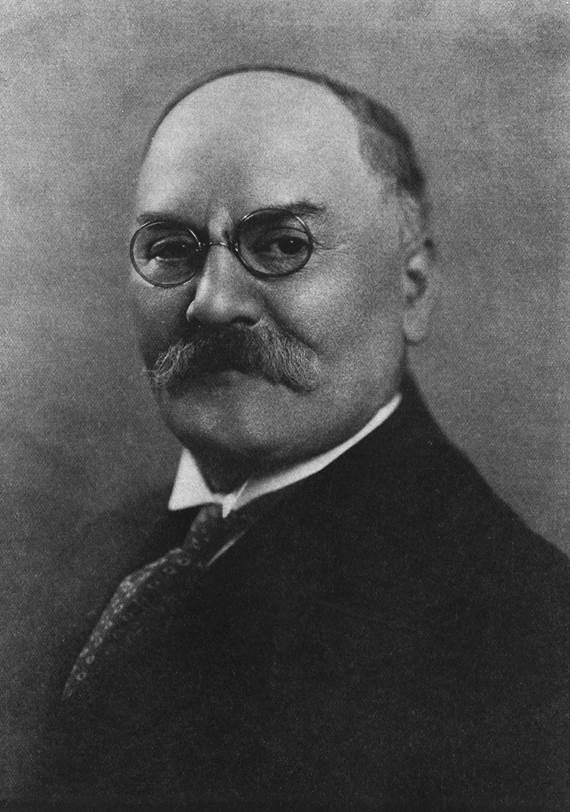 Louis Rubenstein.Photo Credit : Alex Dworkin Canadian Jewish Archives
Louis Rubenstein.Photo Credit : Alex Dworkin Canadian Jewish Archives -
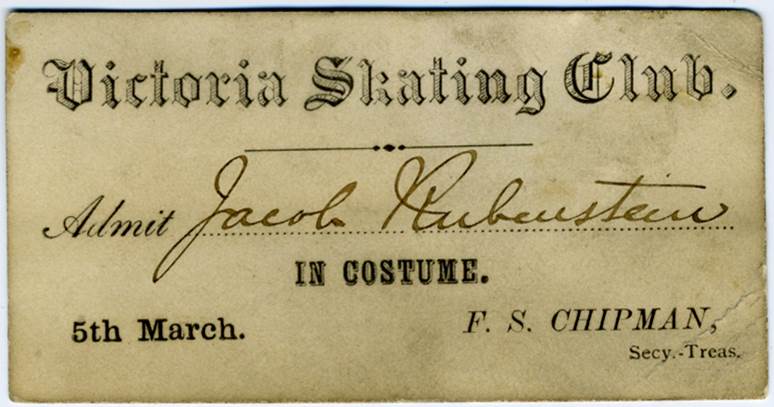 Photograph of a ticket for one of Louis Rubenstein’s ice skating shows (1890s).Photo Credit : Jewish Public Library - Archives
Photograph of a ticket for one of Louis Rubenstein’s ice skating shows (1890s).Photo Credit : Jewish Public Library - Archives -
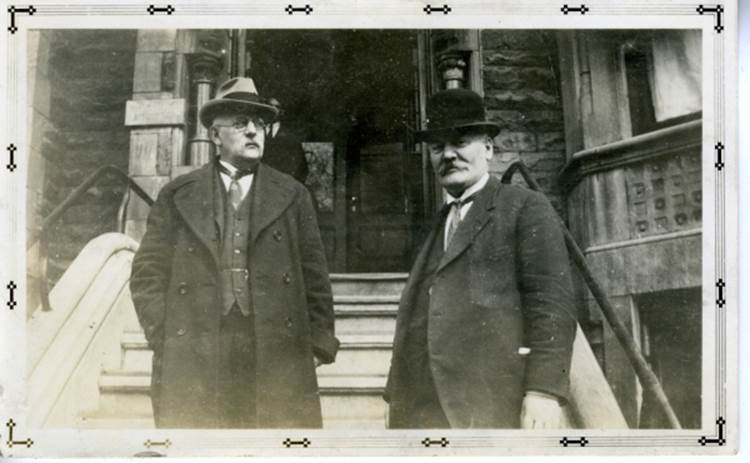 Lazarus and Louis Rubenstein standing on the stone steps of a Montreal building, ca. 1920.Photo Credit : Jewish Public Library - Archives
Lazarus and Louis Rubenstein standing on the stone steps of a Montreal building, ca. 1920.Photo Credit : Jewish Public Library - Archives -
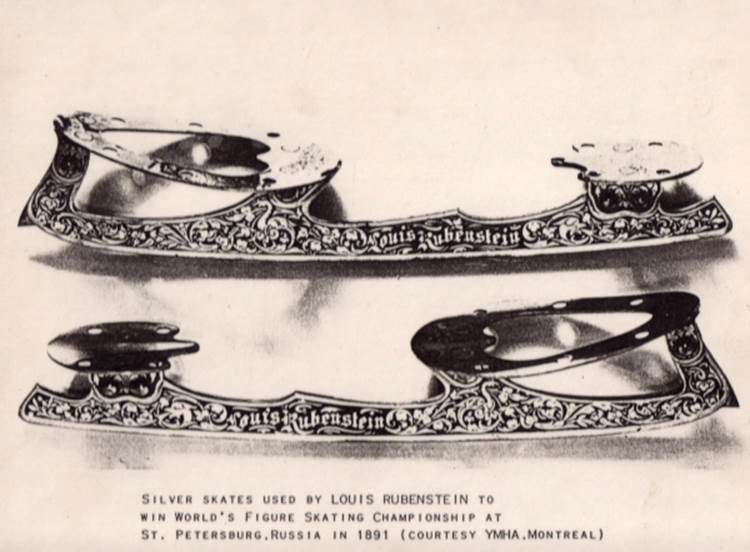 Ice skates of Louis Rubenstein, 1891 figure skating champion.Photo Credit : Jewish Public Library - Archives
Ice skates of Louis Rubenstein, 1891 figure skating champion.Photo Credit : Jewish Public Library - Archives -
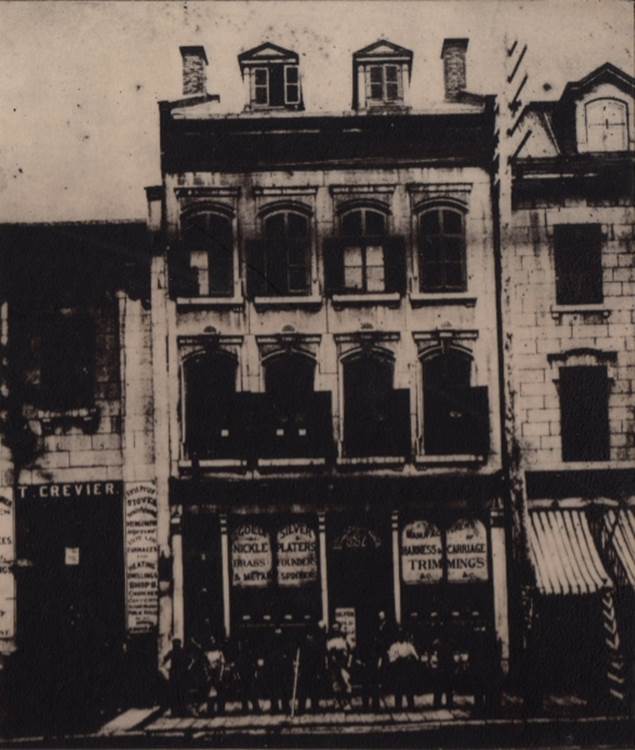 Rubenstein Bros. Co. with childhood home of Louis above on Craig Street (now St. Antoine). Unknown year. From an article by Marven Selicson in Canadian Clothing Journal.Photo Credit : Jewish Public Library - Archives
Rubenstein Bros. Co. with childhood home of Louis above on Craig Street (now St. Antoine). Unknown year. From an article by Marven Selicson in Canadian Clothing Journal.Photo Credit : Jewish Public Library - Archives -
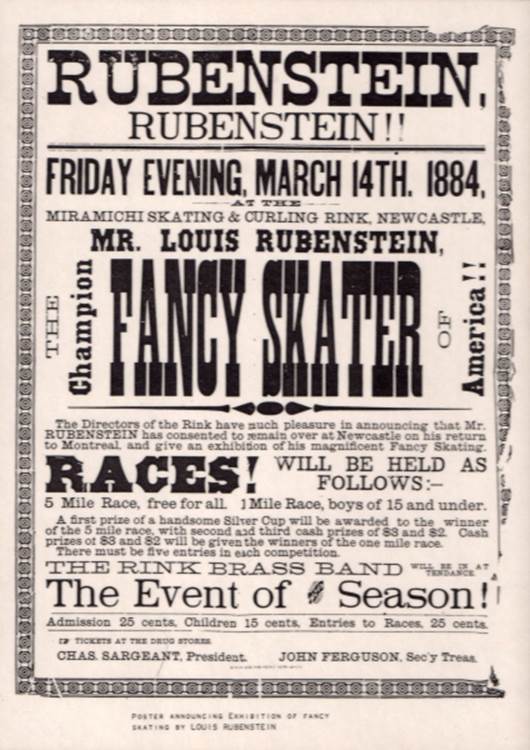 Poster for Louis Rubenstein fancy skating event in 1884.Photo Credit : Jewish Public Library - Archives
Poster for Louis Rubenstein fancy skating event in 1884.Photo Credit : Jewish Public Library - Archives -
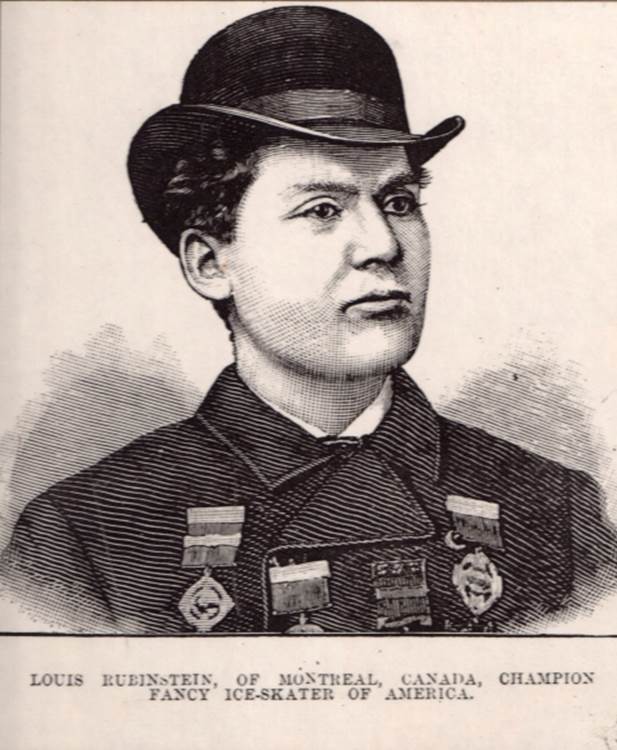 Portrait of younger Louis Rubenstein as ice skater.Photo Credit : Jewish Public Library - Archives
Portrait of younger Louis Rubenstein as ice skater.Photo Credit : Jewish Public Library - Archives
Louis Rubenstein
Louis Rubenstein was Canada’s first international figure skating champion.
Rubenstein was born and raised in Montreal, by a family that owned Rubenstein Bros. Co. Inc. – a successful machinery business. The company’s success gave them the financial means to allow Rubinstein to devote his time to skating. He won the Championship of Montreal in 1878, but it was his performance in 1890 in St. Petersburg, Russia, for which he is most remembered. There, he was confronted with anti-Semitic police harassment and pressure to leave the competition. Despite this discrimination, he won the gold medal and became the first world champion of figure skating, as no other North American figure skater had competed overseas until this time.
In 1887, to remedy worldwide inconsistencies in judges and rules for figure skating competitions, Rubenstein formed the Amateur Skating Association of Canada (ASAC). He remained President of the organization until 1930. Figure skating was not Rubenstein’s only sporting interest; he also enjoyed hockey, curling, bowling and bicycling. He was later named the “Father of Bowling in Canada” by the Montreal Star. He was also referred to as the “Father of North American Figure Skating.” And as a cycling enthusiast, he founded the Canadian Wheelmans’ Association and served as President for 18 years.
Rubenstein eventually retired from professional sports and became involved in city politics, serving as an alderman from 1914 to 1931. During his time in office, the Rubenstein Public Bath was built in his name on Jeanne-Mance Street (now the site of Complexe Desjardins). It served Montreal’s poor, who often lacked running or hot water. Rubenstein was also active in the Jewish community, presiding over the Young Men’s Hebrew Association from 1917 until his death in 1931.
Rubenstein is remembered fondly in Montreal for his athletic career, as well as for his support of labour, and his commitment to the city. He was inducted into the International Jewish Sports Hall of Fame in 1981 and the World Figure Skating Hall of Fame in 1984. There is a memorial dedicated to him in Fletcher’s Field (now Parc Jeanne-Mance).
Special thanks to the Museum of Jewish Montreal
Learn more:
Skate Canada
Hines, James R. Figure Skating: A History. Urbana: University of Illinois Press, 2006.
Inspiring Figure: The Louis Rubenstein Story
International Jewish Sports Hall of Fame
http://www.jewishsports.net/BioPages/LouisRubenstein.htm.
The Unforgettable Louis Rubenstein
Rubenstein Bros. Co. Inc

-
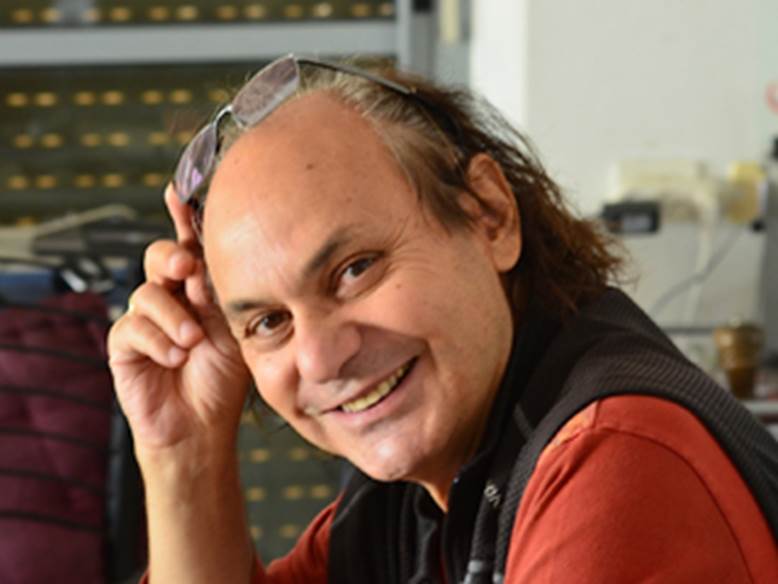 Serge Ouaknine.Photo Credit : http://www.editionsxyz.com/auteur/362.html
Serge Ouaknine.Photo Credit : http://www.editionsxyz.com/auteur/362.html -
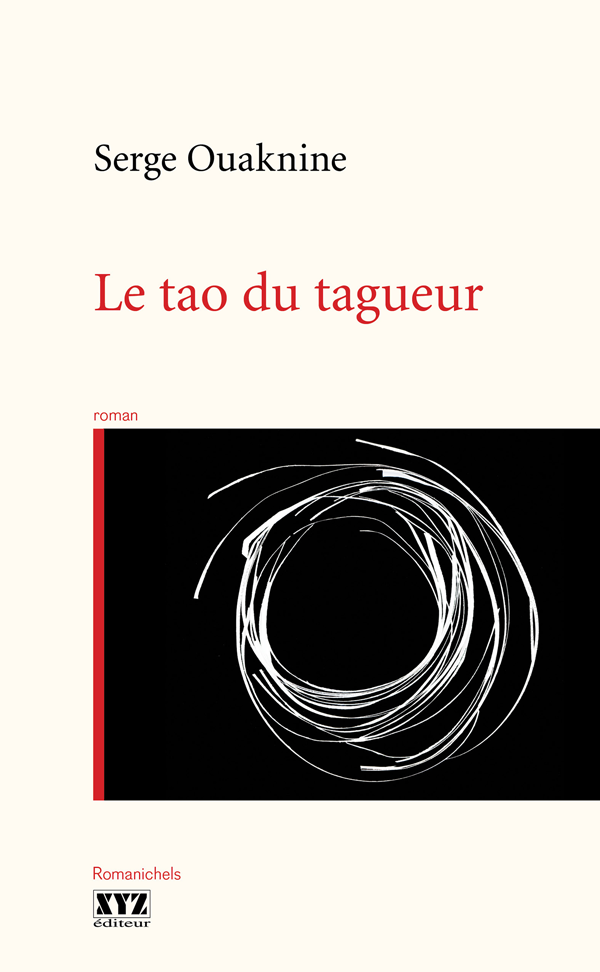 Le tao du tagueur.Photo Credit : http://www.editionsxyz.com/auteur/362.html
Le tao du tagueur.Photo Credit : http://www.editionsxyz.com/auteur/362.html
Serge Ouaknine
Serge Ouaknine is a director, writer and visual designer in Montreal.
Born in Rabat, Morocco, Ouaknine studied in Paris at the National School of Decorative Arts in 1961. He then moved to Warsaw, and later Wroclaw (Breslau), to study with experimental Polish director Jerzy Grotowski.
Ouaknine earned his doctorate in liberal arts and social studies. He directs the Doctoral program in the Study and Practice of Visual Art at UQAM, and teaches theatre there, as well. Since the 2000s, Ouaknine has been involved with the National School of Theatre Arts in Montpellier, France, creating experimental theatre programs for oncologists to help them communicate and interact with their patients.
Ouaknine has written over 40 scripts and more than 250 publications on theatre, acting and poetry. He is also the author of the novel, Le tao du tagueur.
Learn more:
http://clicnet.swarthmore.edu/litterature/moderne/ouaknine/grotowski.html
http://www.editionsxyz.com/auteur/362.html
http://ici.radio-canada.ca/emissions/plus_on_est_de_fous_plus_on_lit/2013-2014/chronique.asp?idChronique=361517

-
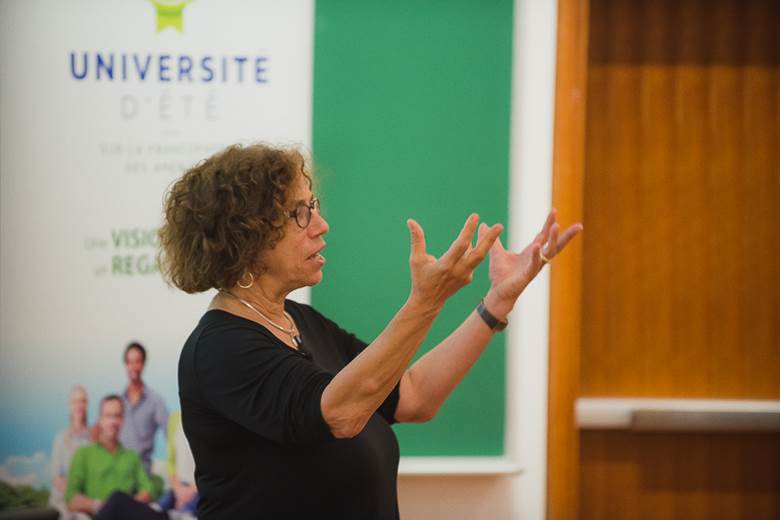 Nancy Neamtan at the Summer School on the Americas Francophonie (2015).Photo Credit : Francophonie Des Ameriques
Nancy Neamtan at the Summer School on the Americas Francophonie (2015).Photo Credit : Francophonie Des Ameriques -
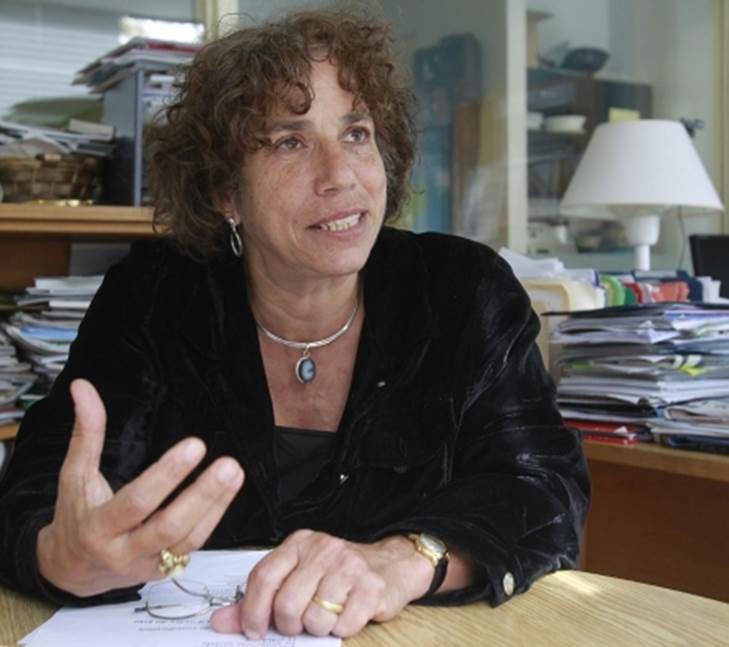 Nancy NeamtanPhoto Credit : Photos Jacques Grenier
Nancy NeamtanPhoto Credit : Photos Jacques Grenier
Nancy Neamtan
Nancy Neamtan, co-founder and long-time CEO of the groundbreaking Chantier d'économie Sociale – a non-partisan autonomous organization that promotes and develops Quebec’s social economy – is an international leader in social justice and community-oriented economic development.
Neamtan was born in Montreal, and did her undergraduate work at McGill University, graduating in 1972. From 1972-1998, she participated in the founding and management of various community organizations around Montreal. Among these groups was the economic program for Pointe-Saint-Charles, the Training Institute in Community Economic Development and Coalition for Economic Recovery social and southwest of Montreal (RESO).
Neamtan served as CEO of Chantier d’économie Sociale for 20 years, President of the Quebec Social Investment Network for 10 years, and the President of the Board of Trustees of the Trust Site. She has also been an important force within the International Labour Organization (ILO).
Neamtan’s honours include being appointed an Officer of the National Order of Quebec (2012), being awarded the title of Doctor Honoris Causa by the University of Quebec in Outaouais (2013), and being given an honorary doctorate by Concordia University (2015) for her efforts in promoting social justice.
Learn more:
http://www.chantier.qc.ca/?module=document&uid=2243
http://transformermontreal.com/fr/speaker/nancy-neamtan/
https://www.ordre-national.gouv.qc.ca/membres/video.asp?id=1105&nom=neamtan-nancy&annee=2012&grade=officier&persiste=1
https://www.youtube.com/watch?v=6BrgHsmaSqM
http://ici.radio-canada.ca/emissions/le_21e/2013-2014/chronique.asp?idChronique=132938

-
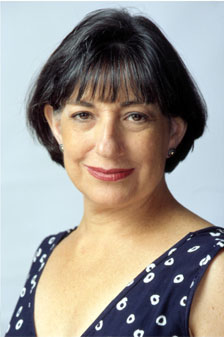 Beverly Shaffer.Photo Credit : http://www.beverlyshaffer.com/
Beverly Shaffer.Photo Credit : http://www.beverlyshaffer.com/
Beverly Shaffer
Beverly Shaffer is an internationally-renowned filmmaker based out of Montreal, whose empathetic and uplifting documentary work focuses on stories of resolve.
Born in Montreal, Shaffer graduated from McGill University in 1967 with a bachelor’s degree in comparative religion. After a short stint teaching high school, she received a master’s degree in film from Boston University in 1971. She began her television career as a production assistant, researcher and associate producer at WGBH, a PBS-affiliate in Boston.
In 1975, Shaffer joined the National Film Board’s famed Studio D, which was dedicated to supporting the work of women filmmakers. It was during this time that Shaffer directed I’ll Find a Way, a documentary about a young girl with spina bifida, which won the 1977 Academy Award for Best Live Action Short Film, one of three Oscars won by Studio D. I’ll Find a Way chronicles the challenges and victories of nine-year-old Nadia who, despite the potential for teasing and taunting at a regular school, is determined to “find a way” to attend.
Shaffer is credited with the Children in Canada series and the Children of Jerusalem series, as well as films like To a Safer Place, which profiles an incest survivor, and was named one of the best films of the decade by the American Film Librarians Association. She has also worked on dramas, including the half-hour drama, The Way It Is, about a young girl dealing with her parents’ divorce.
During her 25 years at the NFB, Shaffer was the recipient of more than 30 awards.
Learn more:
https://en.wikipedia.org/wiki/Beverly_Shaffer
https://www.nfb.ca/film/ill_find_a_way

-
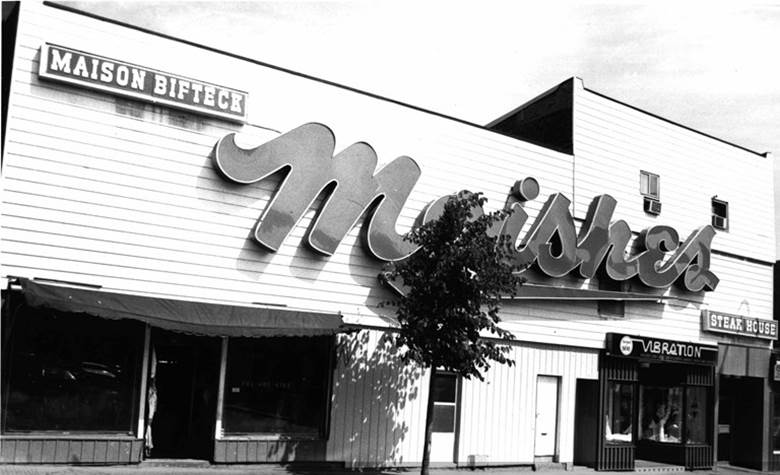 Moishes Steakhouse is located on St. Lawrence Blvd., its original location.Photo Credit : Alex Dworkin Canadian Jewish Archives
Moishes Steakhouse is located on St. Lawrence Blvd., its original location.Photo Credit : Alex Dworkin Canadian Jewish Archives -
 The Moishes dining room in 2014.Photo Credit : Moishes Steakhouse
The Moishes dining room in 2014.Photo Credit : Moishes Steakhouse -
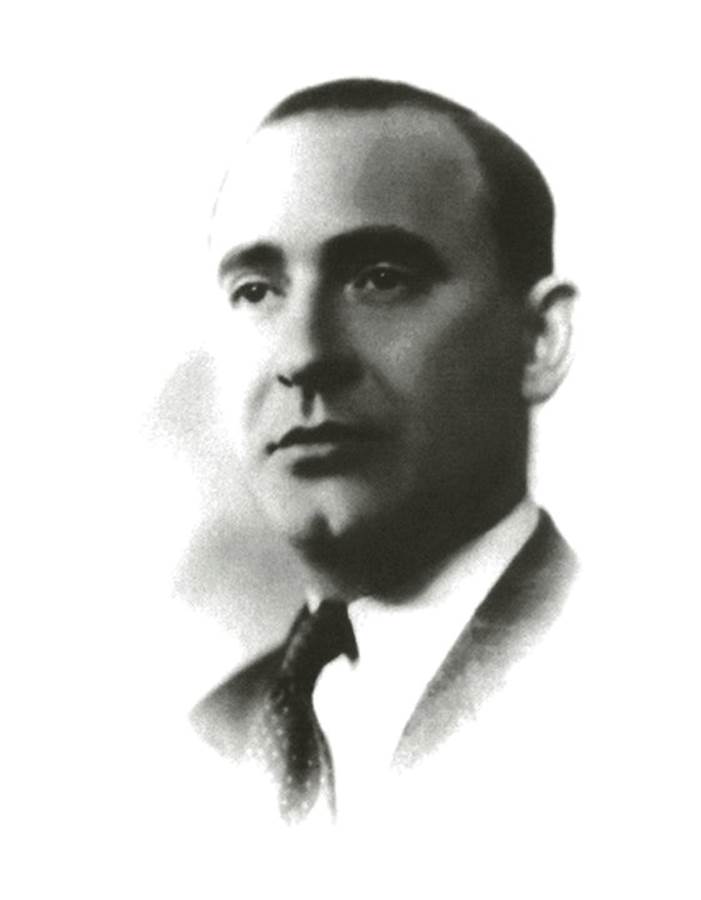 Moishe Lighter, founder of Moishes Steakhouse.Photo Credit : Moishes Steakhouse
Moishe Lighter, founder of Moishes Steakhouse.Photo Credit : Moishes Steakhouse -

-
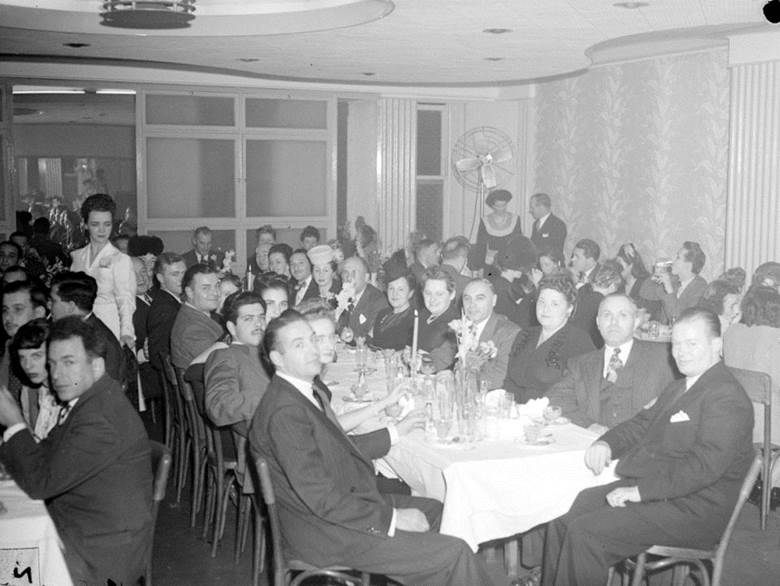 A celebratory reception held at Moishes in 1946.Photo Credit : Conrad Poirier
A celebratory reception held at Moishes in 1946.Photo Credit : Conrad Poirier
Moishes Steakhouse
Moishes Steakhouse is an iconic restaurant that sits along The Main in Montreal, Canada.
The restaurant was founded in 1938 by Moishe Lighter, a Romanian Jewish immigrant to Montreal. He started off working at a smaller restaurant, Yankowitz and Julis, and then poured his savings of $300 into the steakhouse that would bear his name. Known to many as “Romanian Paradise,” the restaurant features Kosher-style Old World classics that would have nourished the hearts and stomachs of the Polish and Romanian Jewish immigrants that lived and worked along St. Laurent Boulevard.
A notorious gambler, legend has it that Lighter became the owner of the restaurant over a card game. What began as just a small-scale meat house is now a staple of “The Main” neighborhood. Culturally, Moishes Steakhouse has also been very influential on the development of broader Montreal cuisine, its steak spice becoming eponymous within the kitchens of not just Montrealers, but Canadians at large.
The steakhouse was also famously featured in the writings of Mordechai Richler, who frequented the restaurant throughout his life. It continues to be the go-to spot for celebrities and locals looking for an authentic taste of The Main.
Learn more:

-
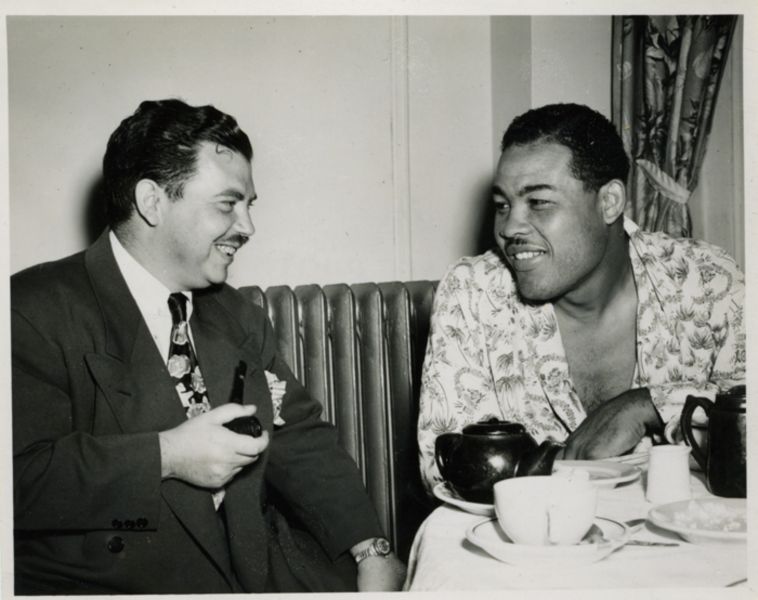 Sam Maltin.Photo Credit : Jewish Public Library - Archives
Sam Maltin.Photo Credit : Jewish Public Library - Archives -
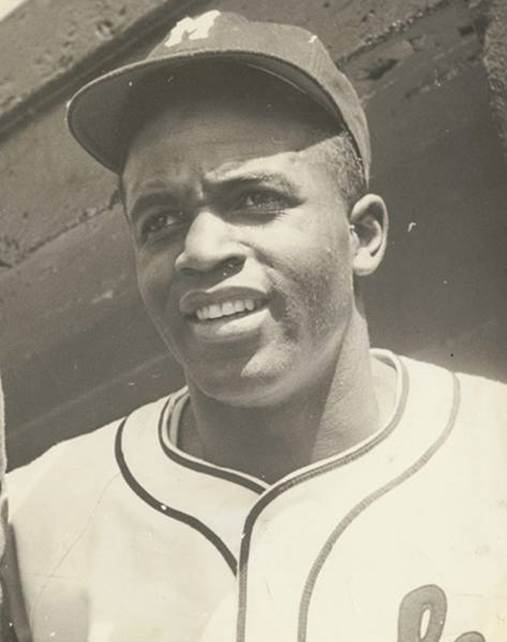 Photograph of Jackie Robinson playing for the Montreal Royals (1946).Photo Credit : Jewish Public Library - Archives
Photograph of Jackie Robinson playing for the Montreal Royals (1946).Photo Credit : Jewish Public Library - Archives -
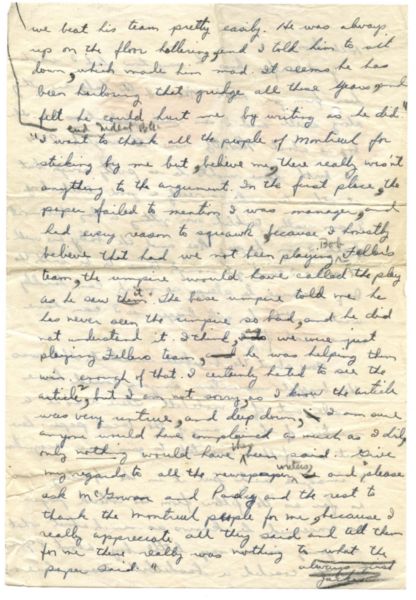 A letter written by Jackie Robinson sent to Sam Maltin.Photo Credit : Jewish Public Library - Archives
A letter written by Jackie Robinson sent to Sam Maltin.Photo Credit : Jewish Public Library - Archives -
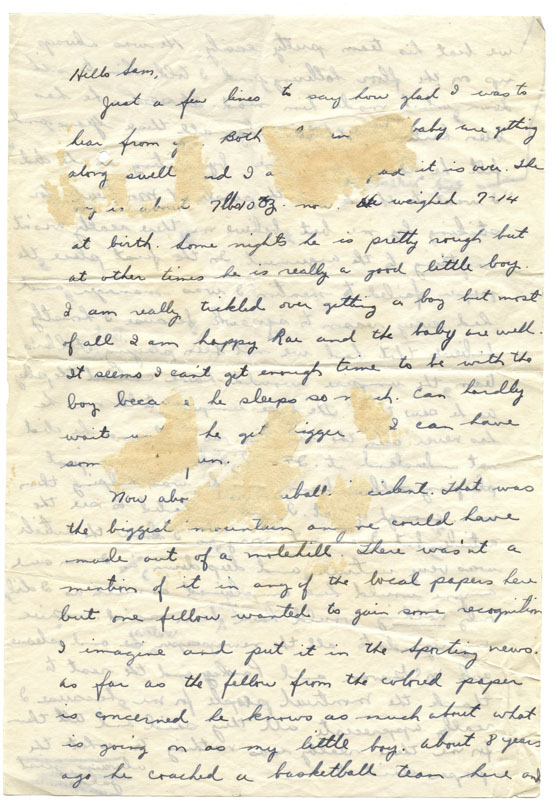 A letter written by Jackie Robinson sent to Sam Maltin.Photo Credit : Jewish Public Library - Archives
A letter written by Jackie Robinson sent to Sam Maltin.Photo Credit : Jewish Public Library - Archives
Sam Maltin
Sam Maltin was a sports journalist for the Montreal Star and Herald newspapers, whose articles not only tackled athletics, but progressive social issues of the day.
Inspired by the predominantly leftist social consciousness of his Montreal Jewish community, Maltin espoused a “radical idealism” in his opinion pieces. Baseball in the 1940s was at a crossroads with race relations. When Jackie Robinson was signed to the Brooklyn Dodgers, he broke the colour barrier, making international news. This momentous event was greeted by American fans with both elation and hostility.
In Montreal, Robinson’s reception was enthusiastic, and Maltin was there to document the story. Robinson’s first home game in the city was on May 1st, 1946, in Delorimier Stadium. He was the biggest sports celebrity Montreal had ever seen. Later that year, Robinson led the Montreal Royals to the Junior World Series title in Montreal. After the win, tens of thousands of fans chased Robinson through the streets. As Maltin famously wrote, “it was probably the only day in history that a black man ran from a mob with love instead of lynching on his mind.”
In addition to writing flattering articles about Robinson’s massive success, Maltin and his wife, Belle, developed a personal relationship with the baseball player and his wife, Rachel. The couples went on to write letters to each other for many years. Robinson maintained a deep appreciation for Maltin’s friendship, and referred to Montreal as “the city that enabled me to go to the major leagues.”
Learn more:
http://www.jewishpubliclibrary.org/blog/?p=1892
http://www.milb.com/milb/features/jackie_robinson.jsp?mc=timeline
http://www.theglobeandmail.com/news/national/jackie-robinsons-wife-remembers-a-welcoming-montreal/article11602715/

-
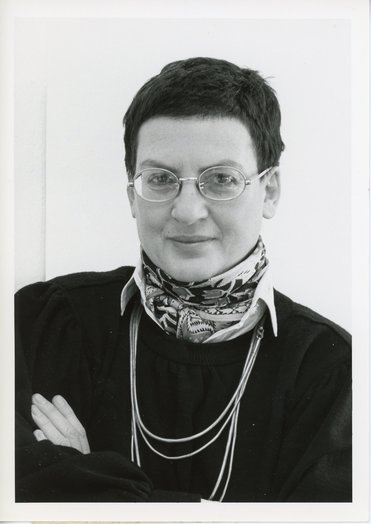 Phyllis Lambert.Photo Credit : Jewish Public Library - Archives
Phyllis Lambert.Photo Credit : Jewish Public Library - Archives -
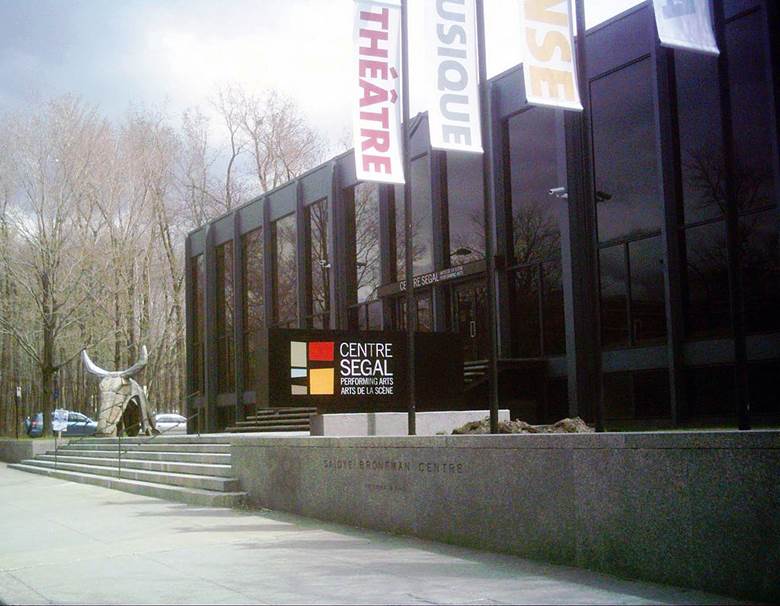 The Segal Centre for Performing Arts, formerly known as the Saidye Bronfman Centre for Arts, was designed by Phyllis Lambert in honour of her mother with Ludwig Mies van der Rohe.Photo Credit : Jean Gagnon
The Segal Centre for Performing Arts, formerly known as the Saidye Bronfman Centre for Arts, was designed by Phyllis Lambert in honour of her mother with Ludwig Mies van der Rohe.Photo Credit : Jean Gagnon -
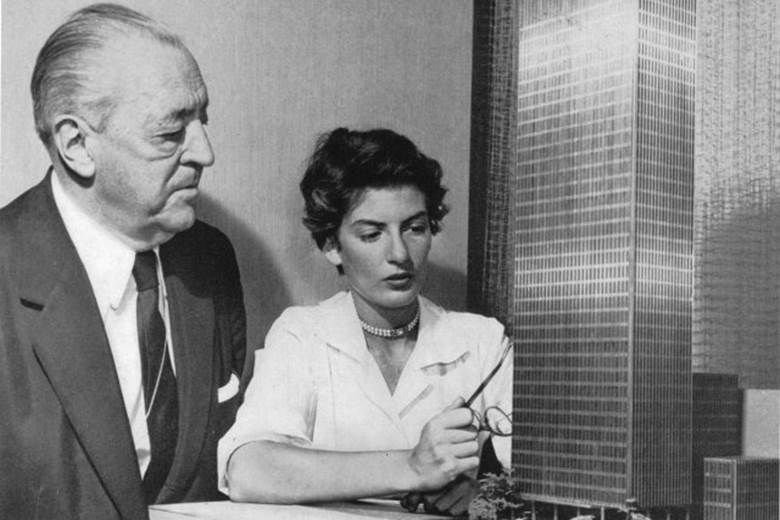 Ludwig Mies van der Rohe and Phyllis Lambert with the model for the Seagram Building, New York, (1955).Photo Credit : Phyllis Lambert Fonds
Ludwig Mies van der Rohe and Phyllis Lambert with the model for the Seagram Building, New York, (1955).Photo Credit : Phyllis Lambert Fonds -
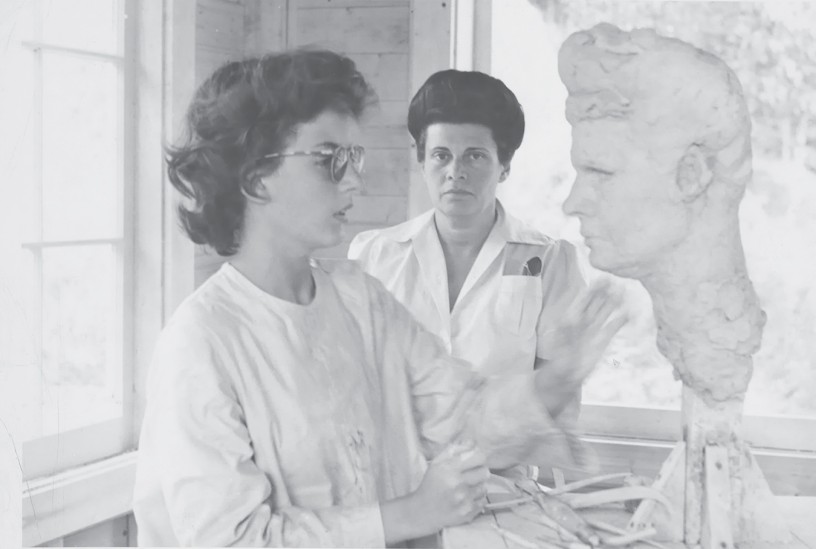 Phyllis Lambert working on a sculpture portrait of her mother Saidye Bronfman, ca. 1950s.Photo Credit : Phyllis Lambert Fonds
Phyllis Lambert working on a sculpture portrait of her mother Saidye Bronfman, ca. 1950s.Photo Credit : Phyllis Lambert Fonds
Phyllis Lambert
Phyllis Lambert is an award-winning Canadian architect, social activist and philanthropist, who founded and directs the Canadian Centre for Architecture in Montreal.
The second daughter of Samuel Bronfman and Saidye Rosner, Lambert grew up in Montreal. She graduated from Vassar College in 1948. While sculpting in Paris, Lambert’s father began construction of his distilling headquarters building in midtown Manhattan, and Lambert worked as the planning director. Following a master’s degree in architecture at Chicago’s Illinois Institute of Technology, she returned to Montreal to design the Saidye Bronfman Centre.
In 1975, Lambert founded the heritage preservation group Heritage Montreal. Four years later, she founded the Canadian Centre for Architecture, a museum and research centre in downtown Montreal. She retired as CCA’s director in 1999, but remains chair of the board of trustees, and an active member of the acquisitions committee.
As an activist, Lambert is deeply interested in preservation-related projects and publications. She has donated money, time and effort to revitalize Shaughnessy Village, along with protesting bad urban construction plans. She has also published books including Court House: A Photographic Document; Photography and Architecture: 1839-1939; Opening the Gates of Eighteenth-Century Montréal; and Fortifications and the Synagogue: The Fortress of Babylon and the Ben Ezra Synagogue, Cairo.
Lambert holds honourary degrees from more than 25 universities and has been made an Officer of France’s Order of Arts and Letters (1992), Companion to the Order of Canada (2001), Grand Officer of the National Order of Quebec (2005). She received an honorary DFA in Architecture from the Pratt Institute in 1990 and was awarded the Vincent Scully Prize in 2006 for a lifetime of outstanding architectural achievements in 2006. She was the 2014 recipient of the Golden Lion at the 14th Venice Architecture Biennale and was awarded the 2016 Wolf Prize in Arts. She was the subject of a 2007 documentary called Citizen Lambert: Joan of architecture.
Learn more:
Roderick McLeod & Eric John Abrahamson, Spirited Commitment: The Samuel and Saidye Bronfman Family Foundation, 1952 – 2007. (Montreal: McGill-Queens University Press, 2010).

-
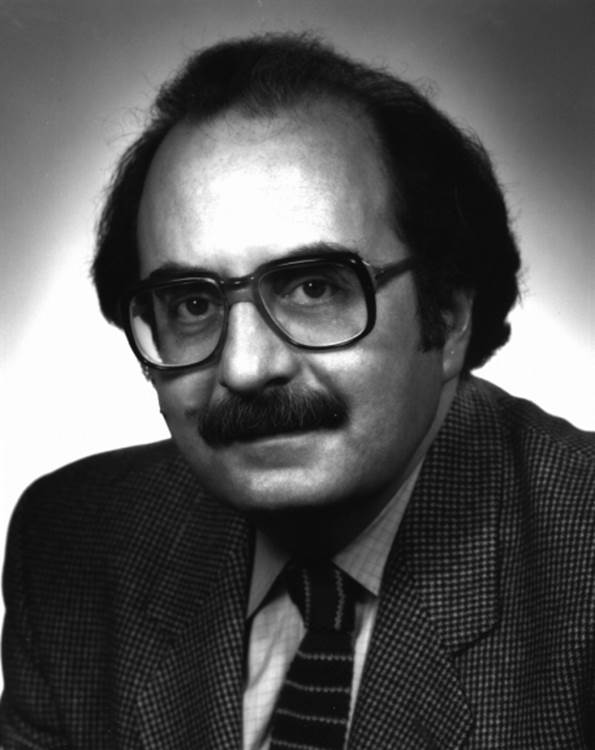 Naïm Kattan.Photo Credit : Alex Dworkin Canadian Jewish Archives
Naïm Kattan.Photo Credit : Alex Dworkin Canadian Jewish Archives -
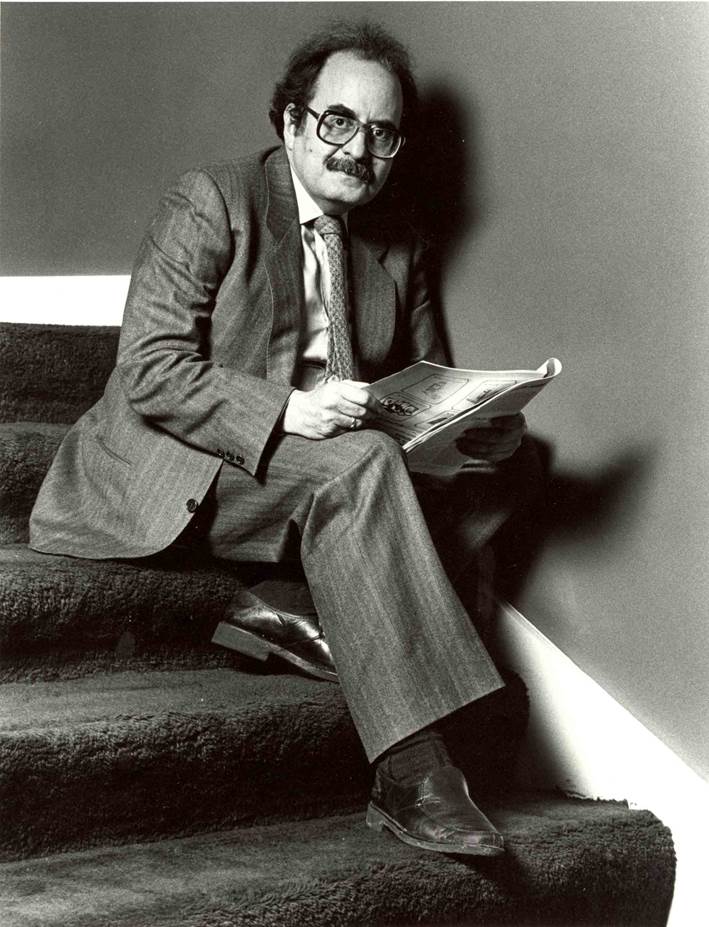 Naïm Kattan, ca. 1960s.Photo Credit : Alex Dworkin Canadian Jewish Archives
Naïm Kattan, ca. 1960s.Photo Credit : Alex Dworkin Canadian Jewish Archives -
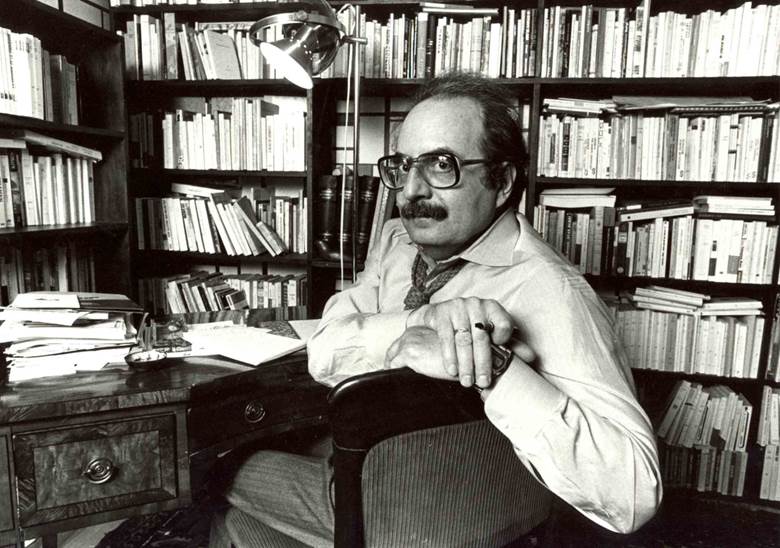 Naïm Kattan, ca. 1960sPhoto Credit : Alex Dworkin Canadian Jewish Archives
Naïm Kattan, ca. 1960sPhoto Credit : Alex Dworkin Canadian Jewish Archives -
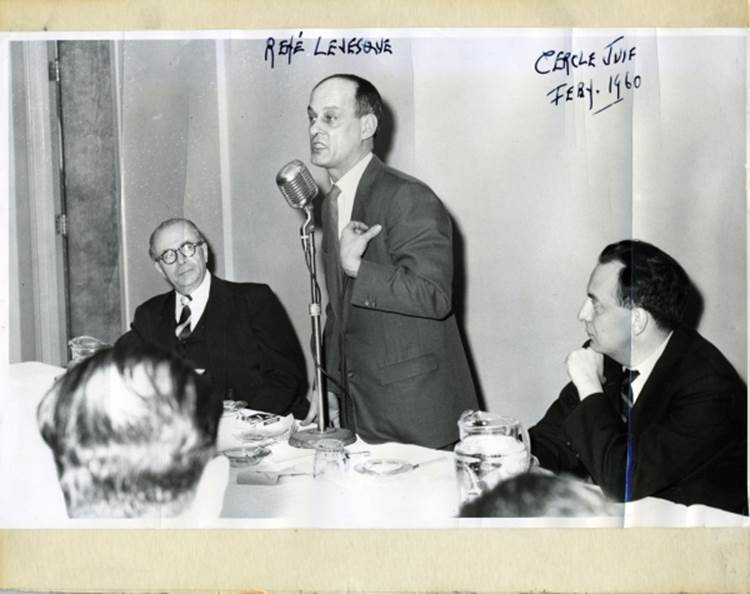 Speakers at the Cercle Juif de langue française meeting, including Réné Lévesque (middle) and Naïm Kattan (right), February 1960.Photo Credit : Jewish Public Library - Archives
Speakers at the Cercle Juif de langue française meeting, including Réné Lévesque (middle) and Naïm Kattan (right), February 1960.Photo Credit : Jewish Public Library - Archives -
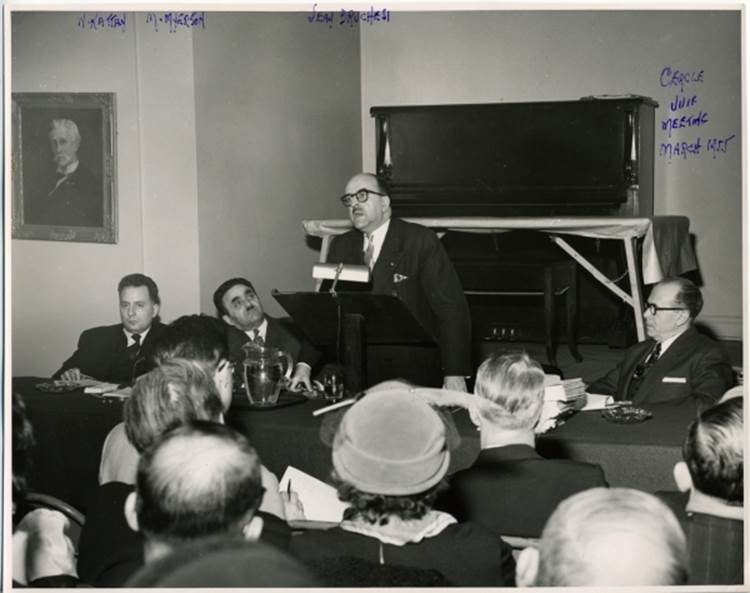 Speakers at the Cercle Juif de langue française meeting, including N. Kattan, M. Myerson, and Jean Bruchesi, March 1955.Photo Credit : Jewish Public Library - Archives
Speakers at the Cercle Juif de langue française meeting, including N. Kattan, M. Myerson, and Jean Bruchesi, March 1955.Photo Credit : Jewish Public Library - Archives
Naïm Kattan
Writer, literary critic and professor, Naïm Kattan, is an iconic figure in Montreal’s Sephardic community, who has published over 30 books and has used his internationalist perspective to build bridges between Quebec’s English and French-speaking communities.
Kattan was born in Baghdad, Iraq, at a time when the life of the city was marked by a strong Jewish presence. After studying law at the University of Baghdad, he received a scholarship from the French government in 1947 to study literature at Université Paris I – La Sorbonne. In 1954, he decided, like many Jews living in the Middle East, to immigrate to Canada, to escape the rising tide of Arab nationalism and anti-Semitism.
In the 1950s, Montreal’s Jewish community was predominantly English-speaking, and Kattan observed the difficulty it had in integrating the new French-language immigrants. (It should be noted that the linguistic situation began to shift in the 1970s, with the community now solidly bilingual.) As a writer, Kattan has published some 30 books in French, including the semi-autobiographical novels Adieu, Babylone (1975; translated as Farewell, Babylon, 1976), Les Fruits arrachés (1977; translated as Paris Interlude, 1979) and La Fiancée promise (1983). Widely translated, his works examine such issues as cultural difference, exile, belonging and nostalgia for lost origins.
Kattan was an active member of the Cercle juif de langue française, created in the early 1950s by the Canadian Jewish Congress as the first French-language Jewish cultural association in Canada. He also founded, through the CJC, the Bulletin du Cercle juif, a newspaper for the French-speaking Jewish community. Kattan went on to write a literary column in Le Devoir, and for close to 25 years he headed the writing and publishing division of the Canada Council for the Arts. Over the course of his career, he has been awarded numerous distinctions, including the Order of Canada, the Ordre du Québec and the J. I. Segal Award for Literature.
Special thanks to the Museum of Jewish Montreal.
Learn more:
http://imjm.ca/location/2519
http://www.cjhn.ca/en/permalink/cjhn207

